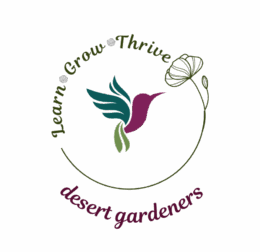When you are thinking about the design of your garden, there are some factors which are always important. The path of the sun and the wind are perhaps the most critical because they create the microclimates in your garden and determine what plans will be able to thrive there.
This is particularly important in desert gardens, where sunshine is generally very abundant—possibly even excessive. Even when planting native plants, you must keep in mind that some of them don’t do well in full sun. Riparian species (those which dwell near rivers) are particularly sued to wetter and shadier conditions than other desert plants.
On the other hand, absence of sun (shade) is also a limiting factor for many desert gardens because it can be difficult to find plants that do well in our dry conditions that don’t also require sunshine. Thus the path of the sun in your yard is a critical piece of information that you need in order to figure out your optimal garden plan.
Desert climates also tend to be rather harsh on plants due to wind. In the summer, wind has a drying effect that can greatly increase a plant’s need for water. In the winter, wind can come down from higher elevations and freeze plants that otherwise might do well in the ambient temperature. For these reasons, it also pays to have an idea of the wind’s path through your garden.
So how do you figure these things out? The time-tested way is simply through observation. It always pays, when you have a new property, to watch it over a year’s time and make a note of where the sun goes, where the shade is, and where the wind tends to blow. Hanging some thermometers in different parts of you yard can also help you figure out your microclimates.
If you’re a bit impatient, there is a tool that can tell you exactly where the sun will fall on your property throughout the year. If you visit the SunCalc website, you can put in your location and figure out the sun’s path at your address in different seasons and times of day. This can be helpful in figuring out your shady and sunny spots. However, keep in mind that you will still need to take into account the presence of surrounding trees, walls, buildings, and other structures that will create shade or reflected heat.
The wind patterns are trickier, because wind direction and speed is greatly affected by nearby objects such as trees, buildings, and even walls. You can find out the prevailing seasonal winds in your area by going to the USDA’s website containing wind data for the entire country. You can view the data as a wind rose which shows you the prevailing winds during any given month for your state and area by clicking through the appropriate folders. The data is in meters per second, which can be converted to miles per hour by multiplying the number by 2.237.
For example, here’s the wind rose for Tucson for the month of April:

This will tell you the general patterns of wind but again, take these with a grain of salt. If you’re near some tall structures, or have mountains or canyons nearby, your particular experience will probably be different. This is why there’s no substitute for sheer observation. A weather sensor (like this one) in your yard can help you figure out your particular patterns.
You can also use an inexpensive windsock if you don’t want to fuss with any electronics, but keep in mind that you will need to monitor that windsock and write down at least occasionally the wind patterns it shows you.
I also highly recommend hanging wireless digital thermometers in your yard to get an idea of the minimum and maximum temperatures in different spots. These thermometers are inexpensive and easy to use and come with multiple sensors. They also display humidity which is another useful piece of data. They also keep track of the minimum and maximum temperature for the year so you can be aware of the trends in your yard.
You’d be surprised how much temperatures in one small yard can vary. In my yard, a shady spot versus a sunny one differs by as much as 10 degrees in the milder seasons, and more in the summer. That makes a huge difference for your plants.
Similarly, the east side of my mom’s yard is closer to a large wash that funnels cold winds down from the mountains and the plants in that location freeze even when there’s no freeze warning posted for Tucson. This is a great example of how being aware of microclimate patterns in your yard can help you determine what plants to place where.



